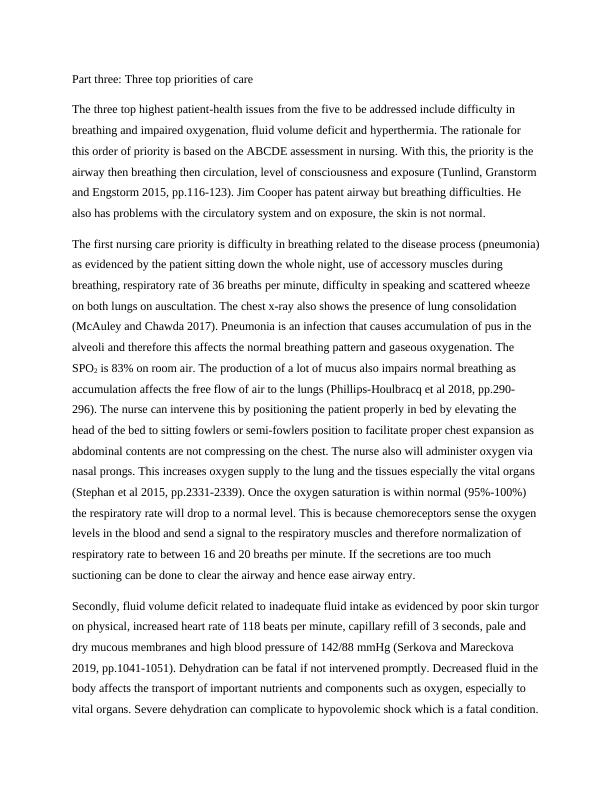Nursing Assignment 2022
Added on 2022-10-11
7 Pages2378 Words14 Views
Nursing
Student Name:
Institutional affiliation:
Student Name:
Institutional affiliation:

Part one: Introduction
I have chosen the case of Jim cooper for this case study and this assessment will be presented
based on the morning shift report. From the case study, Jim cooper falls under the category of
people with a high risk of CAP and also presents with most of the signs and symptoms.
Community-acquired pneumonia is pneumonia acquired outside the hospital setting (Jain et al
2015, pp.835-845). The most common causative pathogens are streptococcus pneumonia,
Haemophilus influenza and atypical bacteria which include: mycoplasma pneumoniae, chlamydia
pneumoniae and legionella species. This infection can occur on its own or following a flu
infection. The most common predisposing factors to community-acquired pneumonia include old
age (>65 years), cigarette smoking, alcohol intake, and immunosuppressive conditions. Other
risk factors include conditions such as COPD, cardiovascular diseases, diabetes mellitus and
chronic liver diseases (Prina et al 2015, pp.153-160). The most common clinical manifestations
of community-acquired pneumonia include productive cough with greenish sputum, high fever,
chills and shivering, sharp chest pains and shallow rapid painful breathing (Prina, Ranzani and
Torres 2015, pp.1097-1108). This condition is however manageable if detected early and
appropriate interventions started as soon as possible.
Part two: Five priorities of care
This assignment will present case study 1, Jim cooper's health priority needs based on the
morning shift report. The five priorities of Jim cooper's health needs include the following: The
patient has difficulty in breathing as the patient reports to be sitting down the whole night and
also use of accessory muscles in breathing and impaired oxygenation due to lung consolidation
as a result of pneumonia (Ahtisham and Jacoline 2015). Secondly, the patient also has signs of
dehydration, therefore fluid volume deficit and decreased cardiac output (Castellan, Sluga, Spina
and Sanson 2016, pp 1273-1286). Besides, the patient is experiencing anxiety due to the
perceived threat to physical and emotional integrity. Jim Cooper has been taking care of himself
independently, and the disease has caused alteration and since he lives alone, anxiety is a result
(Nshimimana et al 2019). Fourthly, hyperthermia related to the body's response to infection as
evidenced by a high temperature of 38 degrees Celsius. Finally, the patient experiences self-care
deficit as he is not able to do all the things, he used to for himself hence requires someone to help
him. Therefore, the patient needs a relative or his child to take care of him.
I have chosen the case of Jim cooper for this case study and this assessment will be presented
based on the morning shift report. From the case study, Jim cooper falls under the category of
people with a high risk of CAP and also presents with most of the signs and symptoms.
Community-acquired pneumonia is pneumonia acquired outside the hospital setting (Jain et al
2015, pp.835-845). The most common causative pathogens are streptococcus pneumonia,
Haemophilus influenza and atypical bacteria which include: mycoplasma pneumoniae, chlamydia
pneumoniae and legionella species. This infection can occur on its own or following a flu
infection. The most common predisposing factors to community-acquired pneumonia include old
age (>65 years), cigarette smoking, alcohol intake, and immunosuppressive conditions. Other
risk factors include conditions such as COPD, cardiovascular diseases, diabetes mellitus and
chronic liver diseases (Prina et al 2015, pp.153-160). The most common clinical manifestations
of community-acquired pneumonia include productive cough with greenish sputum, high fever,
chills and shivering, sharp chest pains and shallow rapid painful breathing (Prina, Ranzani and
Torres 2015, pp.1097-1108). This condition is however manageable if detected early and
appropriate interventions started as soon as possible.
Part two: Five priorities of care
This assignment will present case study 1, Jim cooper's health priority needs based on the
morning shift report. The five priorities of Jim cooper's health needs include the following: The
patient has difficulty in breathing as the patient reports to be sitting down the whole night and
also use of accessory muscles in breathing and impaired oxygenation due to lung consolidation
as a result of pneumonia (Ahtisham and Jacoline 2015). Secondly, the patient also has signs of
dehydration, therefore fluid volume deficit and decreased cardiac output (Castellan, Sluga, Spina
and Sanson 2016, pp 1273-1286). Besides, the patient is experiencing anxiety due to the
perceived threat to physical and emotional integrity. Jim Cooper has been taking care of himself
independently, and the disease has caused alteration and since he lives alone, anxiety is a result
(Nshimimana et al 2019). Fourthly, hyperthermia related to the body's response to infection as
evidenced by a high temperature of 38 degrees Celsius. Finally, the patient experiences self-care
deficit as he is not able to do all the things, he used to for himself hence requires someone to help
him. Therefore, the patient needs a relative or his child to take care of him.

Part three: Three top priorities of care
The three top highest patient-health issues from the five to be addressed include difficulty in
breathing and impaired oxygenation, fluid volume deficit and hyperthermia. The rationale for
this order of priority is based on the ABCDE assessment in nursing. With this, the priority is the
airway then breathing then circulation, level of consciousness and exposure (Tunlind, Granstorm
and Engstorm 2015, pp.116-123). Jim Cooper has patent airway but breathing difficulties. He
also has problems with the circulatory system and on exposure, the skin is not normal.
The first nursing care priority is difficulty in breathing related to the disease process (pneumonia)
as evidenced by the patient sitting down the whole night, use of accessory muscles during
breathing, respiratory rate of 36 breaths per minute, difficulty in speaking and scattered wheeze
on both lungs on auscultation. The chest x-ray also shows the presence of lung consolidation
(McAuley and Chawda 2017). Pneumonia is an infection that causes accumulation of pus in the
alveoli and therefore this affects the normal breathing pattern and gaseous oxygenation. The
SPO2 is 83% on room air. The production of a lot of mucus also impairs normal breathing as
accumulation affects the free flow of air to the lungs (Phillips-Houlbracq et al 2018, pp.290-
296). The nurse can intervene this by positioning the patient properly in bed by elevating the
head of the bed to sitting fowlers or semi-fowlers position to facilitate proper chest expansion as
abdominal contents are not compressing on the chest. The nurse also will administer oxygen via
nasal prongs. This increases oxygen supply to the lung and the tissues especially the vital organs
(Stephan et al 2015, pp.2331-2339). Once the oxygen saturation is within normal (95%-100%)
the respiratory rate will drop to a normal level. This is because chemoreceptors sense the oxygen
levels in the blood and send a signal to the respiratory muscles and therefore normalization of
respiratory rate to between 16 and 20 breaths per minute. If the secretions are too much
suctioning can be done to clear the airway and hence ease airway entry.
Secondly, fluid volume deficit related to inadequate fluid intake as evidenced by poor skin turgor
on physical, increased heart rate of 118 beats per minute, capillary refill of 3 seconds, pale and
dry mucous membranes and high blood pressure of 142/88 mmHg (Serkova and Mareckova
2019, pp.1041-1051). Dehydration can be fatal if not intervened promptly. Decreased fluid in the
body affects the transport of important nutrients and components such as oxygen, especially to
vital organs. Severe dehydration can complicate to hypovolemic shock which is a fatal condition.
The three top highest patient-health issues from the five to be addressed include difficulty in
breathing and impaired oxygenation, fluid volume deficit and hyperthermia. The rationale for
this order of priority is based on the ABCDE assessment in nursing. With this, the priority is the
airway then breathing then circulation, level of consciousness and exposure (Tunlind, Granstorm
and Engstorm 2015, pp.116-123). Jim Cooper has patent airway but breathing difficulties. He
also has problems with the circulatory system and on exposure, the skin is not normal.
The first nursing care priority is difficulty in breathing related to the disease process (pneumonia)
as evidenced by the patient sitting down the whole night, use of accessory muscles during
breathing, respiratory rate of 36 breaths per minute, difficulty in speaking and scattered wheeze
on both lungs on auscultation. The chest x-ray also shows the presence of lung consolidation
(McAuley and Chawda 2017). Pneumonia is an infection that causes accumulation of pus in the
alveoli and therefore this affects the normal breathing pattern and gaseous oxygenation. The
SPO2 is 83% on room air. The production of a lot of mucus also impairs normal breathing as
accumulation affects the free flow of air to the lungs (Phillips-Houlbracq et al 2018, pp.290-
296). The nurse can intervene this by positioning the patient properly in bed by elevating the
head of the bed to sitting fowlers or semi-fowlers position to facilitate proper chest expansion as
abdominal contents are not compressing on the chest. The nurse also will administer oxygen via
nasal prongs. This increases oxygen supply to the lung and the tissues especially the vital organs
(Stephan et al 2015, pp.2331-2339). Once the oxygen saturation is within normal (95%-100%)
the respiratory rate will drop to a normal level. This is because chemoreceptors sense the oxygen
levels in the blood and send a signal to the respiratory muscles and therefore normalization of
respiratory rate to between 16 and 20 breaths per minute. If the secretions are too much
suctioning can be done to clear the airway and hence ease airway entry.
Secondly, fluid volume deficit related to inadequate fluid intake as evidenced by poor skin turgor
on physical, increased heart rate of 118 beats per minute, capillary refill of 3 seconds, pale and
dry mucous membranes and high blood pressure of 142/88 mmHg (Serkova and Mareckova
2019, pp.1041-1051). Dehydration can be fatal if not intervened promptly. Decreased fluid in the
body affects the transport of important nutrients and components such as oxygen, especially to
vital organs. Severe dehydration can complicate to hypovolemic shock which is a fatal condition.

End of preview
Want to access all the pages? Upload your documents or become a member.
Related Documents
Prioritization of Health Issues Case Studylg...
|11
|2516
|25
Bacterial Pneumonia Assignment Reportlg...
|8
|2283
|15
Paper on Integrated Nursing Practicelg...
|9
|2114
|107
Nursing Intervention for Ineffective Airway Clearance, Impaired Gas Exchange and Dehydration Leading to Fluid Volume Deficit (FVD)lg...
|9
|2314
|218
Nursing Management of Pneumonialg...
|11
|3184
|431
Integrated Nursing Practice Assignmentlg...
|8
|2072
|106